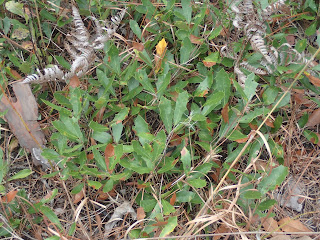In my 24 years in north Florida, I’ve become fascinated by our diversity of oaks. Close relatives usually compete, with only the most successful competitors able to persist. So, how can our 17 species of oaks all manage to live together? The August 2020 Scientific American article “How Oak Trees Evolved to Rule the Forests of the Northern Hemisphere” provides some answers based in part on recent evidence from molecular genetics. Fortuitously, one of the authors, Dr. Jeannine Cavender-Bares, based her extensive research here in north Florida.
All American oaks belong to one of two groups; red oak species have bristles on tips of immature leaves and acorns taking two years to mature; white oaks lack leaf bristles and their acorns mature in a single year. The groups split long ago in geological time. Part of the diversity we see results from red and white species adapting differently to the same conditions, so pairs can often occur together without competing directly. Think of dog-like (Canidae) and cat-like (Felidae) carnivores. Wolves and cougars use the same food resources and coexist, as do foxes and bobcats. The distantly related pairs avoid direct competition because they adapted to shared environments in different ways and use available resources differently.
The following table shows pairings of the red and white oaks that co-occur in our area.
|
Species of Oaks, Genus Quercus, in the Northern Florida Peninsula
|
|||
|
Habitats
|
Species Commonly Occurring Together |
Notes: |
|
|
Red Oaks |
White Oaks |
||
|
Flatwoods/Sandhill/Scrub |
myrtle oak Q. myrifolia |
sand live oak Q. geminata |
medium-size trees |
|
bluejack oak Q. incana |
Chapman’s oak Q. chapmanii |
small trees, shrubs, “clone domes” |
|
|
running oak Q. pumila |
dwarf live oak Q. minima |
ground level shrubs |
|
|
Dry Hammock |
sand laurel oak Q. hemispherica southern red oak Q. falcata |
bluff oak Q. austrina1 |
large trees |
|
turkey oak Q. laevis |
post oak Q. stellata2 |
small to medium-size trees |
|
|
Mesic Hammock |
swamp laurel oak Q. laurifolia Shumard’s oak Q. shumardii1 |
swamp chestnut oak Q. michauxii southern live oak Q. virginiana |
large trees |
|
Pioneers3 |
water oak Q. nigra |
sand post oak Q. margarettae |
large to medium-size trees |
1prefer limestone soils.
2prefer clay or marl soils.
3invade pine flatwoods in the absence of fire, often accompanied by Q. hemisphaerica.
Note that oaks also avoid competition by different growth forms; large trees, small trees, and shrubs deal with fire differently, and occupy different habitats. For example, three closely related white oaks coexist by adapting to different fire and drought regimes. Southern live oak (Q. virginiana) favors moister areas where fires are rare, sand live oak (Q. geminata) favors drier areas with infrequent but devastating fires, and dwarf live oak (Q. minima) occurs in places with frequent low intensity fires.
Thus, moisture, drought, and fire, and adaptations unique to the red oak and white oak lineages help our 17 species of oaks to avoid competition and persist together. To learn more, download the Scientific American article (https://www.scientificamerican.com/article/how-oak-trees-evolved-to-rule-the-forests-of-the-northern-hemisphere/).
Photos and Captions:
Leaves of Southern Live Oak and Sand Live Oak. The cluster on the left is from southern live oak and that on the right from sand live oak. Leaves nearest the three o’clock position are turned over to show their undersides. Southern live oak leaves are flat and wide, unlike the narrower, recurved (curled downward on the long axis and curled under on the short axis) leaves of sand live oak. Southern live oak thrives in moist sites whereas sand live oaks occur in drier, more open places. Cup-like hollows on the undersides of sand live oak leaves create dead air spaces, trapping humidity and preventing water loss. Upper and lower surfaces of southern live oak leaves are green, but the whitish undersides of sand live oak leaves result from microscopic projections that retard evaporative moisture loss.
Dwarf Live Oak. Unlike its close relatives, this species rarely grows more than knee high, adapting to frequent fires by having most of its biomass underground and sending up sprouts after fires. This cluster is growing along the refuge’s Tram Ridge Trail.



No comments:
Post a Comment